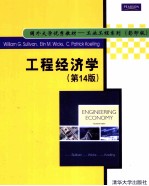图书介绍
工程经济学 英文PDF|Epub|txt|kindle电子书版本网盘下载

- (美)沙利文,(美)威克斯,(美)科林著 著
- 出版社: 北京:清华大学出版社
- ISBN:9787302246961
- 出版时间:2011
- 标注页数:671页
- 文件大小:225MB
- 文件页数:694页
- 主题词:工程经济学-高等学校-教材-英文
PDF下载
下载说明
工程经济学 英文PDF格式电子书版下载
下载的文件为RAR压缩包。需要使用解压软件进行解压得到PDF格式图书。建议使用BT下载工具Free Download Manager进行下载,简称FDM(免费,没有广告,支持多平台)。本站资源全部打包为BT种子。所以需要使用专业的BT下载软件进行下载。如BitComet qBittorrent uTorrent等BT下载工具。迅雷目前由于本站不是热门资源。不推荐使用!后期资源热门了。安装了迅雷也可以迅雷进行下载!
(文件页数 要大于 标注页数,上中下等多册电子书除外)
注意:本站所有压缩包均有解压码: 点击下载压缩包解压工具
图书目录
PART Ⅰ Fundamentals of Engineering Economy1
CHAPTER 1 Introduction to Engineering Economy1
1.1 Introduction2
1.2 The Principles of Engineering Economy3
1.3 Engineering Economy and the Design Process6
1.4 Using Spreadsheets in Engineering Economic Analysis15
1.5 Summary15
CHAPTER 2 Cost Concepts and Design Economics19
2.1 Cost Terminology20
2.2 The General Economic Environment27
2.3 Cost-Driven Design Optimization37
2.4 Present Economy Studies42
2.5 Case Study—The Economics of Daytime Running Lights51
2.6 Summary53
Appendix 2-A Accounting Fundamentals62
CHAPTER 3 Cost-Estimation Techniques71
3.1 Introduction72
3.2 An Integrated Approach74
3.3 Selected Estimating Techniques(Models)82
3.4 Parametric Cost Estimating87
3.5 Cost Estimation in the Design Process98
3.6 Case Study—Demanufacturing of Computers106
3.7 Summary108
CHAPTER 4 The Time Value of Money114
4.1 Introduction115
4.2 Simple Interest116
4.3 Compound Interest117
4.4 The Concept of Equivalence117
4.5 Notation and Cash-Flow Diagrams and Tables120
4.6 Relating Present and Future Equivalent Values of Single Cash Flows124
4.7 Relating a Uniform Series(Annuity) to Its Present and Future Equivalent Values130
4.8 Summary of Interest Formulas and Relationships for Discrete Compounding141
4.9 Deferred Annuities(Uniform Series)142
4.10 Equivalence Calculations Involving Multiple Interest Formulas144
4.11 Uniform(Arithmetic) Gradient of Cash Flows150
4.12 Geometric Sequences of Cash Flows156
4.13 Interest Rates that Vary with Time161
4.14 Nominal and Effective Interest Rates163
4.15 Compounding More Often than Once per Year165
4.16 Interest Formulas for Continuous Compounding and Discrete Cash Flows168
4.17 Case Study—Understanding Economic"Equivalence"171
4.18 Summary174
PART Ⅱ Engineering Economy in Action190
CHAPTER 5 Evaluating a Single Project190
5.1 Introduction191
5.2 Determining the Minimum Attractive Rate of Return(MARR)192
5.3 The Present Worth Method192
5.4 The Future Worth Method201
5.5 The Annual Worth Method202
5.6 The Internal Rate of Return Method206
5.7 The External Rate of Return Method217
5.8 The Payback(Payout) Period Method220
5.9 Case Study—A Proposed Capital Investment to Improve Process Yield222
5.10 Summary223
Appendix 5-A The Multiple Rate of Return Problem with the IRR Method234
CHAPTER 6 Comparison and Selection among Alternatives238
6.1 Introduction239
6.2 Basic Concepts for Comparing Alternatives239
6.3 The Study(Analysis) Period243
6.4 Useful Lives Are Equal to the Study Period245
6.5 Useful Lives Are Unequal among the Alternatives264
6.6 Personal Finances276
6.7 Case Study—Ned and Larry’s Ice Cream Company280
6.8 Postevaluation of Results283
6.9 Summary283
CHAPTER 7 Depreciation and Income Taxes300
7.1 Introduction301
7.2 Depreciation Concepts and Terminology301
7.3 The Classical(Historical) Depreciation Methods304
7.4 The Modified Accelerated Cost Recovery System309
7.5 A Comprehensive Depreciation Example316
7.6 Introduction to Income Taxes320
7.7 The Effective(Marginal) Corporate Income Tax Rate323
7.8 Gain(Loss) on the Disposal of an Asset326
7.9 General Procedure for Making After-Tax Economic Analyses327
7.10 Illustration of Computations of ATCFs331
7.11 Economic Value Added343
7.12 Summary345
CHAPTER 8 Price Changes and Exchange Rates356
8.1 Introduction357
8.2 Terminology and Basic Concepts358
8.3 Fixed and Responsive Annuities364
8.4 Spreadsheet Application369
8.5 Foreign Exchange Rates and Purchasing Power Concepts371
8.6 Case Study—Selecting Electric Motors to Power an Assembly Line376
8.7 Summary379
CHAPTER 9 Replacement Analysis389
9.1 Introduction390
9.2 Reasons for Replacement Ana?ys?s390
9.3 Factors that Must Be Considered in Replacement Studies391
9.4 Typ?al Replacement Problems394
9.5 Determining the Economic Life of a New Asset(Challenger)397
9.6 Determining the Economic Life of a Defender401
9.7 Comparisons in which the Defender’s Useful Life Differs from that of the Challenger404
9.8 Retirement without Replacement(Abandonment)407
9.9 After-Tax Replacement Studies408
9.10 Case Study—Replacement of a Hospital’s Emergency Electrical Supply System418
9.11 Summary421
PART Ⅲ Additional Topics in Engineering Economy431
CHAPTER 10 Evaluating Projects with the Benefit-Cost Ratio Method431
10.1 Introduction432
10.2 Perspective and Terminology for Analyzing Public Projects433
10.3 Self-Liquidating Projects434
10.4 Multiple-Purpose Projects434
10.5 Difficulties in Evaluating Public-Sector Projects437
10.6 What Interest Rate Should Be Used for Public Projects?438
10.7 The Benefit-Cost Ratio Method440
10.8 Evaluating Independent Projects by B-C Ratios446
10.9 Comparison of Mutually Exclusive Projects by B-C Ratios448
10.10 Criticisms and Shortcomings of the Benefit-Cost Ratio Method453
10.11 Case Study—Improving a Railroad Crossing455
10.12 Summary457
CHAPTER 11 Breakeven and Sensitivity Analysis465
11.1 Introduction466
11.2 Breakeven Analysis466
11.3 Sensitivity Analysis473
11.4 Multiple Factor Sensitivity Analysis479
11.5 Case Study—Analysis of a Business Venture483
11.6 Summary486
CHAPTER 12 Probabilistic Risk Analysis495
12.1 Introduction496
12.2 Sources of Uncertainty497
12.3 The Distribution of Random Variables497
12.4 Evaluation of Projects with Discrete Random Variables501
12.5 Evaluation of Projects with Continuous Random Variables510
12.6 Evaluation of Uncertainty by Monte Carlo Simulation515
12.7 Performing Monte Carlo Simulation with a Computer519
12.8 Decision Trees523
12.9 Real Options Analysis532
12.10 Case Study—The Oils Well That Ends Well Company535
12.11 Summary539
CHAPTER 13 The Capital Budgeting Process548
13.1 Introduction549
13.2 Debt Capital551
13.3 Equity Capital552
13.4 The Weighted Average Cost of Capital(WACC)555
13.5 Project Selection559
13.6 Postmortem Review563
13.7 Budgeting of Capital Investments and Management Perspective564
13.8 Leasing Decisions565
13.9 Capital Allocation567
13.10 Case Study—Financing an Automobile575
13.11 Summary578
CHAPTER 14 Decision Making Considering Multiattributes581
14.1 Introduction582
14.2 Examples of Multiattribute Decisions582
14.3 Choice of Attributes584
14.4 Selection of a Measurement Scale584
14.5 Dimensionality of the Problem585
14.6 Noncompensatory Models585
14.7 Compensatory Models590
14.8 Summary598
PART Ⅳ Appendices604
A Using Excel to Solve Engineering Economy Problems604
B Abbreviations and Notation621
C Interest and Annuity Tables for Discrete Compounding625
D Interest and Annuity Tables for Continuous Compounding644
E Standard Normal Distribution648
F Selected References651
G Answers to Selected Problems654
Index659